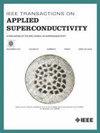IF 1.7
3区 物理与天体物理
Q3 ENGINEERING, ELECTRICAL & ELECTRONIC
引用次数: 0
摘要
在高能物理磁体中,通常会使用超导电缆,其中一个原因是为了限制电感,从而限制磁体淬火时的电压。对于 LTSC 电缆来说,这还允许在磁链发生局部扰动时进行电流共享;这种电流共享可减轻 LTSC 超导低最小淬火能带来的问题。对于 HTS 股,MQE 要大得多,但也出现了一个同样重要的功能,即导体冗余。电缆内的小缺陷导致的发热可以通过股间电流共享再次得到缓解。在这种情况下,REBCO 带堆、Roebel 和 CORC 电缆尤其值得关注。在这种情况下,原始带子上可能会出现小缺陷,无论是在布线过程中还是在磁体中使用时。无论这些缺陷是如何产生的,如果不存在电流共享,都会产生局部加热。在本文中,我们模拟了非绝缘磁带堆栈(即磁带堆栈电缆)中的电流共享情况,该堆栈包含七条双面磁带,其中一些磁带存在缺陷。在本文中,我们使用有限元法 (FEM) 建模,假设这些带子的临界电流密度与在 4.2 K(沸腾液体 He)下的运行有关。本文章由计算机程序翻译,如有差异,请以英文原文为准。
Current Sharing in Defected Superconducting REBCO Tape Stack Cables for HTS Inserts in Accelerator Magnets: FEM Modeling
In high energy physics magnets, superconducting cables are typically used, one for this reason is to limit inductance and thus voltages during magnet quench. For LTSC cables this also allows for current sharing in case of a local perturbation of a strand; such current sharing mitigates problems attendant to the low minimum quench energy seen in LTSC superconductors. For HTS strands, MQE is much larger, but an equally important function has emerged which is conductor redundancy. Heating due to small defects within the cable can be mitigated again by strand-to-strand current sharing. Of particular interest in this context are REBCO tape stacks, Roebel and CORC cables. Here small defects may arise in the original tapes, either during cabling or in service in the magnet. However they arise, local heating can be generated if current sharing is not present. In this article, we modelled the current sharing in non-insulated tape stacks (i.e., tape stack cables) containing seven double-sided tapes with defects present in some of the tapes. In this article, we used Finite Element Method (FEM) modeling, assuming critical current densities of these tapes relevant for operation at 4.2 K (boiling liquid He).
求助全文
通过发布文献求助,成功后即可免费获取论文全文。
去求助
来源期刊

IEEE Transactions on Applied Superconductivity
工程技术-工程:电子与电气
CiteScore
3.50
自引率
33.30%
发文量
650
审稿时长
2.3 months
期刊介绍:
IEEE Transactions on Applied Superconductivity (TAS) contains articles on the applications of superconductivity and other relevant technology. Electronic applications include analog and digital circuits employing thin films and active devices such as Josephson junctions. Large scale applications include magnets for power applications such as motors and generators, for magnetic resonance, for accelerators, and cable applications such as power transmission.
 求助内容:
求助内容: 应助结果提醒方式:
应助结果提醒方式:


